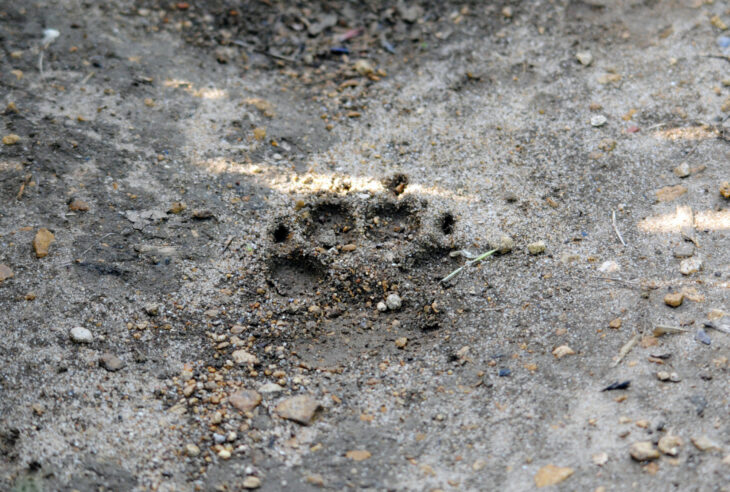You can find animal tracks anywhere – in city parks, in your garden or in rural countryside. It is easiest to spot them in muddy places, or when it has snowed. Or you could try setting up a footprint trap! Leave a sand-filled tray outside your house overnight and see who’s been to visit in the morning – find out what you need to do it below!

Below are some animal tracks you might come across. Remember take a note of the size and shape, and the number of toe or ‘claw’ marks you can see. A photograph can be a handy way to help identification back at home!
 Deer prints display their cloven hooves. Deer prints have two oblong and pointed toe impressions that sit alongside each other, making the shape of an upside-down heart. Different species of deer can be hard to tell apart, but generally, the small muntjac leaves tracks that are about 3cm long, while the impressively large red deer leaves tracks up to 9cm long.
Deer prints display their cloven hooves. Deer prints have two oblong and pointed toe impressions that sit alongside each other, making the shape of an upside-down heart. Different species of deer can be hard to tell apart, but generally, the small muntjac leaves tracks that are about 3cm long, while the impressively large red deer leaves tracks up to 9cm long.

Badger prints are very robust and broad (6.5cm wide). They show long claw marks and have five toe pads in front of a wide rear pad. Their front and back paws differ slightly: the front-paw marks have longer claw marks, while the back-paw marks show the inner toes to be a little further forward.

Duck prints have three claws with visible webbing in between them, while bird prints show a long middle toe, two shorter and splayed outer toes, and a long backward-pointing toe. Swans display prints like ducks, but just much larger!

Otters’ prints are webbed and large (up to 9cm long and 6cm wide), with five toes and a large rear pad impression. Claw marks aren’t usually visible, and sometimes only four toes imprint, but if it’s a muddy area, you might just see the distinctive ‘drag’ of a tail.

Dog prints are easy to recognise. They have four toes and a big pad, with short, blunt claws. The size can vary depending on the dog breed!

Squirrel prints have five toes like every mammal, and all five will show up in their footprints. The claw marks normally show in the mud or snow. The feet have pads and tracks that are made on a firm surface. They look like a bunch of little spots.

Fox footprints have 4 slender toe prints and one large heel pad print. This gives their tracks an oval shape, although some have described them as being diamond-shaped!
What you will need:
- An old baking tray
- Long ruler
- Fine grain sand
- Water
- A low sided dish
- Meat based cat or dog food
- Footprint ID guide (optional)
- Camera (optional)
How to make your footprint trap:
You can download the activity guide below.
- Fill the baking tray with sand and use the ruler to smooth the surface.
- Check that the trap works by lightly pressing your finger into the sand – it should leave an indent. If it does, smooth over the sand again.
- Place a dish with pet food in the middle of the tray and leave the tray in the garden overnight.
- Check the tray in the morning for animal footprints.
- You can use a footprint ID guide or the footprint pictures above to help identify who has been using your garden!
Tell us what you saw using #DiscoverLearnPlay
